Images of Egypt
|
|
We have made several visits to Egypt and have taken hundreds of photographs, most of these are of temples and tomb inscriptions
which will be familiar to anyone who has visited the main tourist sites. A few, however, are of momuments which may be unfamiliar
to most visitors to this most fascinating of countries and a selection is reproduced in these pages. I have also included some of
buildings and statues which I have particularly enjoyed and I hope that you enjoy them to.
Click on the link or photograph below to view the slideshow for each location.
|
|
Abu Simbel
|
The rock-cut Abu Simbel temples, a UNESCO World Heritage Site, were carved out of the hillside during the reign of Ramesses II
as monuments to himself and his chief queen Nefertari.
They originally stood on the bank of the Nile in Nubia, about 230 km southwest of Aswan, close to the modern border with Sudan, but
were relocated in 1968 and now stand on the western bank of Lake Nasser.
|
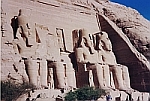
|
|
Abydos
|
The Royal Necropolis at Abydos, the burial place of Narmer, founder of the first dynasty, his successor Aha and several other early pharaohs,
dates from the 1st Dynasty. During the First Intermediate Period, the principal deity of the area, Khentiamentiu gradually merged with Osiris
and Abydos eventually became the centre of the Isis and Osiris cult.
The 19th Dynasty pharaoh Seti I founded a temple honouring the ancestral pharaohs of the early dynasties; this was finished by his son Ramesses II.
|
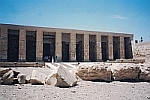
|
|
Aswan
|
Aswan, the ancient city of Swenett [Gk. Syene], stands on the banks of the Nile just downstream of the First Cataract,
the first barrier to navigation south of the Nile Delta. During the Dynastic Period the quarries of Aswan, which may still be visited,
were celebrated for their fine-grained granite [syenite] which was used for colossal statues, obelisks, and shrines throughout Egypt.
|
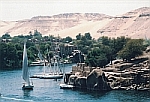
|
Museum of
Egyptian
Antiquities
Cairo
|
Beginning with the great Mosque of Muhammad Ali Pasha constructed at the summit of the Citadel but
primarily devoted to objects in the superb Museum of Egyptian Antiquities in Tahrir Square.
The museum's original collection was established in the late 19th century by Auguste Mariette and now contains the world's most extensive
collection of pharaonic artefacts.
|

|
|
Dashur
|
In the 15th year of his reign [c.a. 2600 BCE] Sneferu, the first Pharaoh of the 4th Dynasty, abandoned attempts to construct a pyramid
at Meidum and founded a new necropolis at Dashur. Here he built the first two true pyramids, the Bent Pyramid and the Red Pyramid,
to have survived more or less intact to the present day.
|
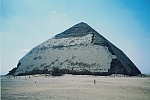
|
|
Dendera
|
The 40,000 square meter Dendera temple complex is surrounded by a substantial mud-brick wall.
Although the site appears to date from the time of the 6th Dynasty Pharaoh Pepi I and there are traces of an 18th Dynasty temple the earliest
building on the site today dates from the reign of Nectanebo II, the last of the native pharaohs.
The main temple at Dendera, the Temple of Hathor was built in the late Ptolemaic period and is among the best preserved temples in Egypt.
|
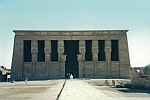
|
|
Edfu
|
The Ptolemaic temple dedicated to Horus at Edfu was built on the site of an earlier, smaller temple also dedicated to Horus.
Considered to be the best-preserved cult temple in Egypt, construction of the present temple began in 237 BCE during the reign
of Ptolemy III and was completed in 57 BCE under Ptolemy XII.
|

|
|
Giza
|
The Royal Necropolis at Giza comprises the pyramids of the 4th Dynasty pharaohs Khufu, Khafre and Menkaure with their causeways
and valley temples, the Great Sphinx, the mastaba tombs of high officials and nobles and the associated royal workshops and workmen's barracks.
A highlight of any visit to Giza is the Solar Boat Museum, which houses Khufu's painstakingly reconstructed royal barge.
|
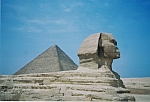
|
|
Kom Ombo
|
The northern part of the unique Ptolemaic double temple at Kom Ombo was dedicated to the falcon god Haroeris [Horus the Elder],
along 'with Tasenetnofret [the Good Sister, a special form of Hathor or Tefnut) and Panebtawy [Lord of the Two Lands]'.
The southern part was dedicated to the crocodile god Sobek, god of fertility and creator of the world with Hathor and Khonsu.
The temple is almost perfectly symmetrical along the main axis.
|
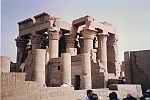
|
|
Philae
|
The small island of Philae, just above the First Cataract, was held in high reverence by the Egyptians and the Nubians as one of the burying-places of Osiris.
Since the construction of the Aswan Low Dam in 1902 the largely Ptolemaic era temple was submerged for much of the year and
in the 1960s the entire temple complex was moved 500m to higher ground on the Island of Agilkia to avoid its loss after completion of
the Aswan High Dam.
|

|
|
Saqqara
|
Saqqara, on the west bank of the Nile opposite the ancient capital of Memphis, is a vast necropolis with dozens of pyramids and mastaba tombs
dating from the 3rd Dynasty through to the Ptolemaic and Roman eras. The most famous monument at Saqqara is Djoser's Step Pyramid complex,
constructed by his master architect Imhotep around 2620 BCE, and claimed to be the first major building project to be made entirely of stone.
|
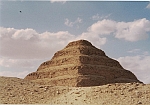
|
Thebes
[Luxor]
|
Ancient Thebes, the modern city of Luxor, standing on the east bank of the Nile about 30 miles south of the Qena Bend, has with some justification
been described as the world's greatest open air museum, having the spectacular ruins Luxor and Karnak temples in the city itself and the no less
impressive mortuary temples and tombs of the New Kingdom pharaohs close by on the west bank of the Nile.
|
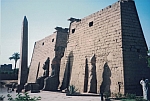
|
Thebes
[Karnak]
|
The construction of the Karnak temple complex began under the Middle Kingdom pharaoh Senusret I, continuing into the Ptolemaic period.
It is a vast area of ruined temples, chapels, pylons, and other buildings; mostly dating from the New Kingdom.
Known as 'The Most Selected of Places' [Ipet-isut] it was the main cult centre of the 18th Dynasty Theban Triad headed by the god Amun.
|
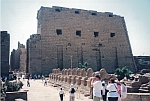
|
Thebes
[West Bank]
|
The New Kingdom Royal Necropolis is situated west of the Nile opposite Luxor.
The river bank is lined with the mortuary temples of the New Kingdom pharaohs, including the impressive Ramesseum [Ramesses II] and the
colossal statues of Memmnon [Amenhotep III].
Directly opposite Karnak temple the impressive mortuary temple of Hatshepsut lies further back at Deir el Bahri, behind which
is the Valley of the Kings, a narrow winding valley in the foothills of the Theban mountains.
|
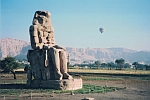
|
|
References
|
I used the following reference works to refresh my memory when compiling the photograph annotations:
'The Complete Tutankhamun' by Nicholas Reeves, Thames and Hudson, 1990, ISBN 0-500-05058-9
'Chronicle of the Pharaohs' by Peter Clayton, Thames and Hudson, 1994, ISBN 0-500-05074-0
'The Complete Pyramids' by Mark Lehner, Thames and Hudson, 1997, ISBN 0-500-05084-8
'The Complete Valley of the Kings' by Nicholas Reeves and Richard H Wilkinson, Thames and Hudson, 1997,
ISBN 0-500-05080-5
'The Ancient Egyptian Book of the Dead' by R O Faulkner, British Museum Press, 2000, ISBN 0-7141-0946-0
'Egypt The Rough Guide' by Dan Richardson, Rough Guides, 1996, ISBN 1-85828-188-1
|
|
Return to the main Home page
This document and photographs are © Chris Newall 2016 and are not for sale or general publication.
The photographs may not be reproduced without permission.
|













